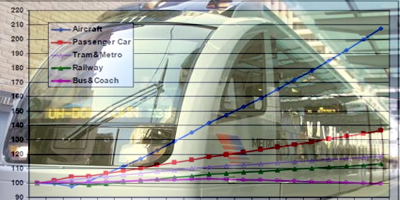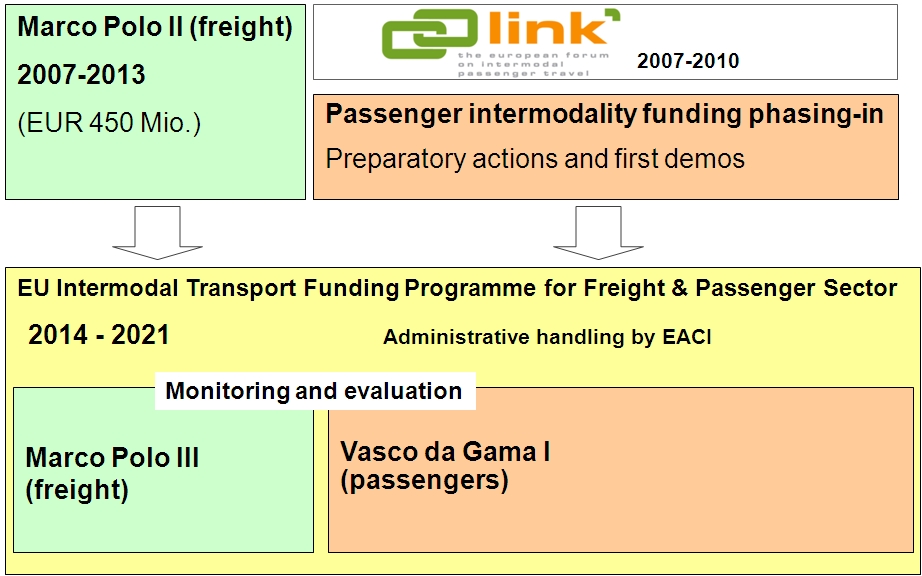
 The LINK project has created a European Forum on Intermodal Passenger Travel in order to enhance the combined use of different transport modes on one single journey, with its focus on long distance trips and thus also on cross-border travelling. This stresses the context of an often unknown environment for the traveller.
The LINK project has created a European Forum on Intermodal Passenger Travel in order to enhance the combined use of different transport modes on one single journey, with its focus on long distance trips and thus also on cross-border travelling. This stresses the context of an often unknown environment for the traveller.
The project LINK – launched in April 2007 – is funded by the European Commission (DG Mobility and Transport) within the 6th Framework Programme. It lasted 3 years but the intention has been to sustain this platform the funding period. LINK has been a project managed by a group of 17 different partners: research organisations, networks and consultants with a high level of external stakeholder awareness.
Intermodality: challenge – background – vision
Enhanced intermodality is supposed
to increase the efficiency of the transport system,to improve the ease of travelling on side of the travellers andto minimise the impacts on environment and climat.Intermodality is in most cases not a purpose on its own and requires efforts by the traveller to change from one sub-system to another (e.g. from tram to train or from bus to plane).
A crucial point is that facilitating services offer complementarities and substitution of user involvement – however, full integration is illusion. This promising principle is still associated much more to the freight sector than to the passenger sector.
The mobility trends and forecasts (passenger sector) have in recent decades and seem to increase further the imbalance in favour for less sustainable modes. The fast growth in air transport by 4.5% per year and the increase of road transport volumes by 1.6% per year for the period 1995-2007 are the relevant aspects concerning the intermodal competition.
The loss of significance of rail transport over many years has turned to slightly increase (at least on some corridors), but bus and coach tend to decline. The background of the modal share is an ongoing growth of passenger transport. The European Commission expected in 2006 an annual growth rate of 1.9 % for the period 1995-2004, which is contrasting to an actual growth by 1.7% per year on average (1995-2007) [3] and an expected growth of 1.5 % on average annually for the period 2000-2020, which makes 35% over the whole 20 years period).

These figures highlight the necessity to foster the use of the more sustainable modes which are mostly used in combination, thus intermodal trip chains.
Intermodal trips over long distances (>100 km total length) are a segment of the transport market with particularities. Long distance trips are made less frequently in contrast to trips with shorter distances, but they account for many person-km – slightly simplified: about 2 % of the trips account for 20% of the person-km travelled in total. Additionally, there are big differences in the population: Few people are travelling long distances (10% of the population account for 50% of the trips). Besides, the differences between various countries are considerable, but also between different trip purposes (see table).

The current status in Europe is heterogeneous and multifaceted; to travel across Europe on a single ticket and provided with door-to-door information is still a splendid vision – in reality often very difficult.
One major challenge that must be met, if we are to achieve this vision, is to align cooperation with competition. Setting up a Forum to bring together the various relevant stakeholders to overcome market and policy fragmentation, to transfer knowledge and to promote intermodal solutions can be seen crucial.
Lots of efforts have been made, many projects have been and are still running related to topics which are relevant for intermodal transport, but a lack of exchange is visible.
Outcomes of the project
The project has generated a network of stakeholders and experts, a good practice database, a Virtual Library for research and a set of practical recommendations on how to further long distance passenger intermodality.
The LINK community LINK has created a large community of stakeholders (currently, the contact database includes around 1200 entries). Dissemination of information and good practice, participation in working groups and conferences as well as consultation processes were the main activities involving experts with different scientific disciplines and institutional backgrounds such as public authorities, operators, operators groups, user groups, academia, politics, business and industry.

The recommendations are of course not comprehensive, but cover many of the key challenges that must be addressed. They include policy and funding ideas for the EU, international standardisation themes and ideas for intermodal service, all of which can be taken up and developed further and needed to be promoted by platforms, networks and interest groups. All key results are available in the paper “Recommendations and Strategies for Passenger Intermodality in Europe” (full version and summary) – and may be seen as the most relevant outcome of the LINK project.
Three out of these recommendations in brief:
— Intermodal journey planner
A main intention of the LINK recommendations and the vision of LINK is to create a European door-to-door information service in the area of long distance intermodal passenger transport. Reality is that there are a number of systems on national, regional and local level, but only few are transnational. To achieve the vision it seems recommendable to create first a European vision on this by a White Paper. A road-map explores the technical co-operation in achieving such a journey planner. A European directive is needed which requires transport operators to make basic travel planning data available (e.g. standardised tariff and timetable information). Standardisation in technology could be achieved within the Technical Specifications for Interoperability for Telematic Applications for Passenger (TAP TSI), defined by the ERA (European Railway Agency). One of the important standardisation efforts should focus on the electronic ticketing for long distance rail / coach to allow compatibility with local public transport fare management systems.
Proposed approach for advanced European intermodal information and ticketing policy.

— Funding for intermodality
Another recommendation is a new funding scheme for intermodal transport demonstration projects (working title “Vasco de Gama”). It could be set up jointly with the MARCO POLO programme for the freight sector in the new period (2014-2021).

Quality standards and management for interchanges
Interchanges are facilities which are prerequisites for almost every intermodal trip. Despite their relevance a broad variety of actual design and functionalities can be observed which often hinders seamless travelling.
This could be tackled by common standards for the equipment of interchanges (from accessibility to the transport-related infrastructure, information services as well as transport-related rental services and other additional services), which have to take into account findings from previous studies and projects. Standards should be facilitated by the provision of guidelines and general principles for building new interchanges or adapting existing interchanges. An interactive and web-based toolkit with good practice examples is supposed to support stakeholders involved in interchange design.
As a long-term vision, the desired standards could be integrated in the existing standards of the European Committee for Standardisation (CEN/ TC 320) and thus gain more momentum.
Interchanges well designed according to the needs of the users do not only require a common format for the phase of planning and building, but they also need to be run and maintained in this sense. This is related to effective interchange management which ensures that the aforementioned principles are applied in sound business models with the profile of Interchange Managers at their heart.
Continuation
Some practical steps were made to ensure the continuation of the work of LINK and help turn the recommendations into reality. Within the projects some feasible ideas have been sketched in how to develop it into a forum in the more precise sense of a formalised stakeholder membership with its own organisation and financing model. LINK is considered to be a good idea worth continuing, said the vast majority of respondents who answered a questionnaire concerning the “life after” of the project.
The future work should have a primary focus on
• Workshops, conferences and networking
• Best practice documentation
• EU policy position papers and policy “lobbying”
• Developing pilot projects
Due to the focus of LINK, long distance passenger intermodality, mainly on the European level, there is a lack of a direct advocate amongst single mode operator groups or single governments and authorities.
There are some funding opportunities which may allow pursuit of some parts of the LINK agenda and specific LINK recommendations. Short-term options could be upcoming projects in the framework programme, INTERREG or IEE/STEER. The main medium to long-term funding is seen the proposed intermodal funding programme. LINK+ could also have nominal membership fees.
Case studies
Demonstrating implementation is crucial for concepts. Intermodality needs to convince by successfully implemented projects. Nevertheless it has turned out to be difficult to identify a large number of cases fitting into LINK’s focus. In particular the relevance of long distances was a difficulty as more examples documented are about local transport. However, about 70 entries can be searched in the LINK case studies database (accessible on the website).
Research
Since the LINK Forum aimed at involveing many actors from various sectors, the (academic) research has of course also been included. The objective of this part of the project was to identify research results on the topic in order to facilitate decision-making in favour for intermodality based on consolidated knowledge. This has been achieved by screening many hundreds of research results and providing abstracts of research works according to LINK’s scope (intermodal passenger transport with relevance for long distance travelling). The Virtual Library – a publically accessible database on the website allowing queries – contains currently almost 350 entries.

Future prospects
The challenges in and for the transport sector are demanding; they include the protection of the climat and other environmental aspects as well as social concerns like societal inclusion next to economic aspects. They can only be tackled by an integrated approach which has to comprise the integration of modes, but requires many more aspects and fields of action – see figure 5.
———————————————————————–
Contact and further information:
Patrick Hoenninger
ILS – Research Institute for Regional and Urban Development Dortmund, Germany (LINK co-ordinator)
Email: [email protected]
www.linkforum.eu
Phone: +49 231 9051-121